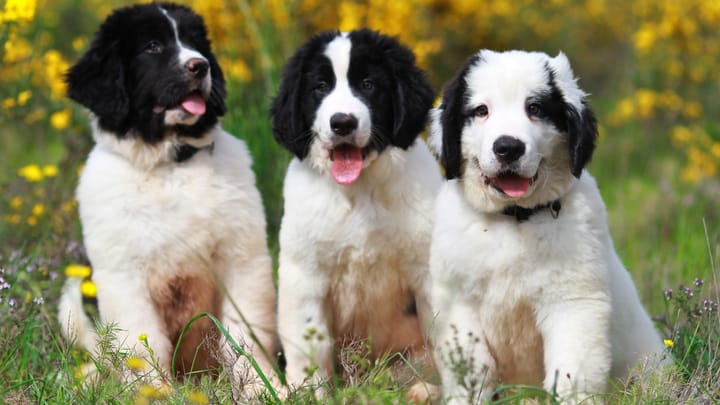Landseer
Other names : Landseer Newfoundland, Landseer ECT (European Continental Type)


There is more to distinguish the Landseer from the ‘common or garden’ Newfoundland dog than her colour. Yes, she’s black and white, compared to the purely black or brown standard Newfoundland, but her legs are a bit longer, too. See! Totally different dog! Yet depending where you are standing, some regard her as a spin-off of the Newfoundland, and others an altogether separate breed. Well, when she sits on you there will be less chance for fuss, because this gentle giant is enormous and full of love. Even if she’s relatively little trouble pound-for-pound, a dog of this size is always going to need a little special attention. Do you have room in your heart – and in your home – for a Landseer?
|
Life expectancy |
The Landseer has a life expectancy of between 7 and 9 years |
|
Temperament |
|
|
Size |
Large
|
|
Adult size |
Female
Between 26 and 28 in
Male
Between 28 and 31 in
|
|
Adult weight |
Female
Between 110 and 154 lb
Male
Between 110 and 154 lb
|
|
Coat colour
Black and white. |
Black White |
|
Type of coat
Straight, dense double coat. |
Long |
|
Eye colour
Darker browns. |
Brown
|
This dog really loves swimming. Although it’s not essential for her well-being, living near water will make her very happy.
More details about the Landseer
Landseer: Origins and history
Developed in the north of Canada, the Landseer is an off-shoot of the Newfoundland, and probably has bits of St. Bernard, English Mastiff, and Great Pyrenees about her as well as the extinct, indigenous Newfoundland dog, the St. John’s. She is named for Sir Edwin Landseer, who painted her in 1838 (which is to say he made a portrait of her, not that he’s the one that added the white spots to her coat).
Physical characteristics of the Landseer
An ‘absolute unit,’ as the contemporary turn of phrase has it, this bi-coloured giant is unruly of hair and lumbersome of limb, yet noble and dignified with it. Her short, muscular neck leads to broad, powerful shoulders and eventually round to a neatly tucked belly; though you may lose sight of her line through that soft, heavy fur. This softness is magnified through her deep-set eyes, square face, and friendly expression. Her ears are flappy and fringey: bliss.
FCI classification of the Landseer
-
Group 2 - Pinscher and Schnauzer - Molossoid and Swiss Mountain and Cattledogs
-
Section 2 : Molossian type
Landseer: Characteristics
Landseer: Behaviour
Training a Landseer
Although she is very kind and affectionate, she has a very strong temperament that sometimes makes education complicated, especially if too brutal and inappropriate methods are used.
Landseer: Lifestyle
Breed compatibility Landseer
Landseer: Purchase price
We do not have enough data to set and average price, but you can expect to pay upwards of £1000 for a well-bred puppy. Looking after a dog of this size typically costs between £140 and £220 a month, including food, medical/insurance, and incidental expenses.
Landseer: Grooming
A thorough weekly brushing is necessary to deal with this furry doggo’s spectacular ‘do. If she swims in salt water, she should be rinsed in fresh water immediately afterwards.
Landseer: Health
This dog is moderately healthy, but she has a short average lifespan of around 8 years.
This dog is quite sturdy, although she doesn’t live very long.
Not brilliantly, due to the Landseer’s size and thick coat.
She deals quite well with the cold, as befits her northern heritage.
If her meals aren’t balanced, she can put on weight.
- Hip/Elbow Dysplasia
- Gastric Dilation Volvulus (bloat)
- Thrombopathia
- Joint Conditions (osteoarthritis)
- Aortic stenosis
- Ectropion / entropion
- Cystinuria
- Platelet disorder
- Ear infections
- Epilepsy







